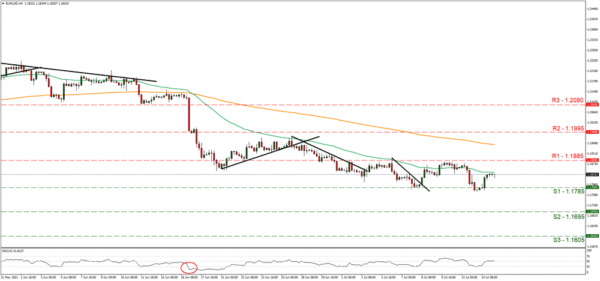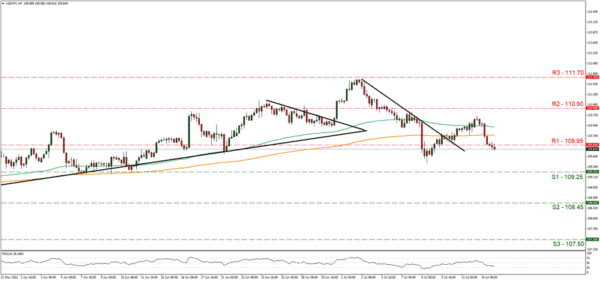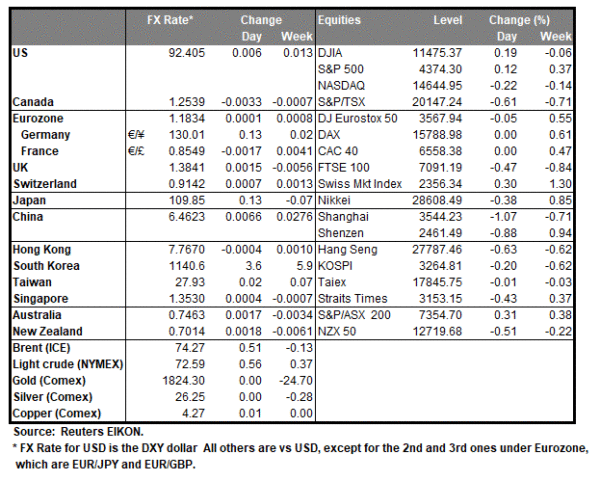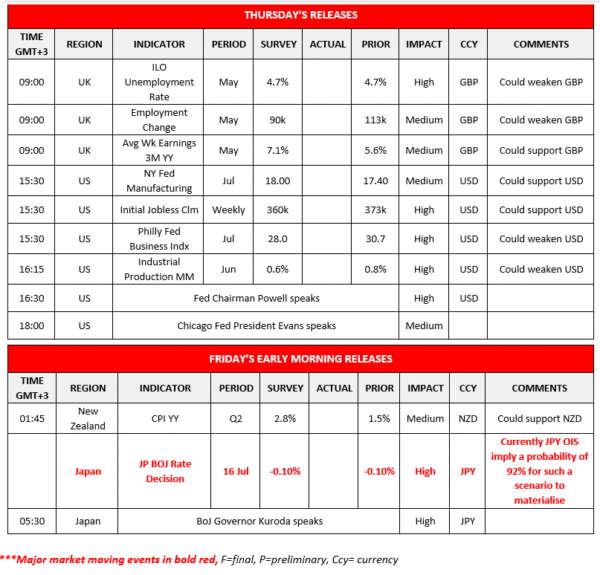The greenback weakened against a number of its counterparts yesterday while US stockmarkets gained as did also gold after Fed Chairman Powell struck a dovish tone in his testimony before Congress yesterday. Powell eased market worries for a tightening of the bank’s monetary policy, as he stated that high inflation seemed linked to the U.S. economy’s reopening, that it would be a mistake to act prematurely and that economic conditions for tapering bond buying was “still a ways off”. On the other hand, analysts tend to note that spiking coronavirus cases across the globe, from the US to Sydney, may have created some safe haven inflows for the greenback. Today we highlight the US financial releases and note the second testimony of Fed Chairman Powell before Congress.
EUR/USD rose yesterday after bouncing on the 1.1785 (S1) support line yet remained with the boundaries of its sideways movement. We tend to maintain our bias for a sideways movement between the 1.1885 (R1) and the 1.1785 (S1) levels. It should be noted that the RSI indicator below our 4-hour chart is at the reading of 50 also implying a rather indecisive market. Should a buying interest be displayed by the market we may see EUR/USD breaking the 1.1885 (R1) resistance line and aim for the 1.1995 (R2) resistance level. Should sellers be in charge of the pair’s direction, we may see the pair breaking the 1.1785 (S1) support line and aim for the 1.1695 (S2) support level.
BoJ to sound cautiously optimistic?
During Friday’s Asian session, we get from Japan BoJ’s interest rate decision. The bank is widely expected to remain on hold, keeping rates at -0.10% and currently JPY OIS imply a probability of 91.62% for such a scenario. One highlight could be whether the bank is to cut back on the economy’s growth rate projection or not, which would enhance its dovishness even further or offer a cautiously optimistic view of the economy in the fresh quarterly projections due out tomorrow. The renewed state of emergency to weaken the spreading of Covid 19 could hurt local consumption and increase the reliability of the growth factor for the economy on exports. Overall, the bank is expected to retain its expectations for a moderate recovery and may lower the GDP growth rate somewhat for the current year, while at the same time upgrade it for the coming year. Should the bank rely more on its usual dovishness, we may see the Yen weakening somewhat, albeit JPY may be more sensitive to safe haven flows.
USD/JPY dropped yesterday breaking the 109.95 (R1) support line, now turned to resistance. We tend to maintain a bearish outlook for the pair, given that the RSI indicator below our 4-hour chart is at the reading of 50, implying a rather indecisive market. Should the bears actually be in control of the pair’s direction, we may see USD/JPY, aiming if not breaking the 109.25 (S1) support line. Should the bulls take over, we may see the pair breaking the 109.95 (R1) resistance line and aim for the 110.90 (R2) resistance level.
Other economic highlights today and the following Asian session:
Today during the European session, we note the release of the UK employment data for May. In the American session, we get from the US the NY Fed Manufacturing for July, the weekly initial jobless claims figure, the Philly Fed Business index and the industrial production growth rate for June. On the monetary front, besides the second testimony of Fed Chair Powell before Congress we also note the release of Chicago Fed President Evans. During tomorrow’s Asian session, before BoJ’s interest rate decision, we get New Zealand’s CPI rates for Q2.
Support: 1.1785 (S1), 1.1695 (S2), 1.1605 (S3)
Resistance: 1.1885 (R1), 1.1995 (R2), 1.2090 (R3)
Support: 109.25 (S1), 108.45 (S2), 107.50 (S3)
Resistance: 109.95 (R1), 110.90 (R2), 111.70 (R3)


















